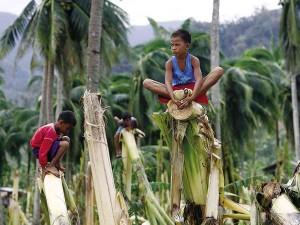
LABUYO’S FURY Boys in Dipaculao town, Aurora, sit on the stumps of banana plants toppled by Typhoon “Labuyo” that ravaged the province on Monday. RAFFY LERMA
BALER, Aurora—When government workers finally cleared the debris left by Typhoon “Labuyo” from the road linking the coastal towns of Dipaculao, Dinalungan and Casiguran, one of the first to rush home on Wednesday was the parish priest of Casiguran.
Fr. Jofran Talaban spent Tuesday in this capital town waiting for roads to Casiguran to open. He was stuck in Baler after arriving from Manila where he joined the Agta community on Monday in filing a lawsuit against the Aurora Pacific Economic Zone and Freeport.
Aurora is no stranger to typhoons so Talaban was certain residents there knew what to do. He said he was informed that the Agta villagers who did not join him in Manila had fled to the forests and stayed in a communal hut until the typhoon passed. The Agta and the rest of their town’s communal spirit enable them to survive storms with no casualties.
But the impact of Labuyo was too much to take for relief workers and soldiers who brought truckloads of food and goods to the towns on the outskirts early on Wednesday.
Fallen coconut and banana trees littered the stretch of the road. Macario Boldit sat on a hill overlooking 3 hectares of toppled coconut trees. “It will take me another year to recover from this,” he said.
Some houses along the coastline of Casiguran had toppled down, as if a fairytale wolf had huffed and puffed.
Their worst typhoon
Evangeline Andres said she and her seven children were awake at 2 a.m. on Monday when Labuyo’s winds swept away their kitchen and destroyed several huts which they used to rent out to visitors.
Many of Andres’ neighbors suffered the same fate.
“We had other typhoons before that hurt us, like [Typhoon] ‘Pepeng’ in 2009,” said Jocelyn Nakalipay, a neighbor. But they said Labuyo was the worst typhoon they had seen in years.
Another family was busy scouring around the beach for nails. The mother said they had to repair their roof but could only keep it intact using worn-out iron staves they found along the shoreline.
Some families tried to make light of their cleanup chore. They brought out their house speakers and blasted the neighborhood with dance music.
Power has been out in the area since Monday. The lines are still in the middle of the road, occasionally obstructing trucks and vehicles that drove through the area.
Road cleanup
But families powered their radio using car batteries. People danced while pulling off rotting roof materials off the road.
Soldiers also helped with the cleanup. They began repairing the roofs of Abuel Elementary School.
Laarni Rosilas, a Grade 3 teacher, said some classrooms had been cleaned for Grades 1 to 3, but the children have not returned to school.
“That’s probably because their parents are busy repairing their homes. I have not been able to check. We have no phone signals at the moment,” she said.
One group of people was seen crowding together at a corner in Dipaculao because it was the only place with faint telephone signals. That was one of the reasons few people knew about the situation in Casiguran, Talaban said.
Some houses were under water when a nearby river overflowed, isolating the town center for two days.
There used to be a bridge but half of it collapsed last year and people used to cross by wading through the shallow river bed. The current had been too strong even for vehicles on Monday, but it calmed down a bit on Wednesday, allowing soldiers to finally bring in supplies.
Most of Aurora’s roads escaped the onslaught unscathed. But the carpet of withered trees along the roadside has made the sight in this part of the province a little unsettling.
The provincial board on Wednesday declared the northeastern towns of Dinalungan, Casiguran and Dilasag under a state of calamity.
Dinalungan, Casiguran and Dilasag face the Pacific Ocean on the east and are rimmed by the Sierra Madre mountain ranges on the west. Two routes to Aurora—via Pantabangan and Bongabon in Nueva Ecija—are prone to landslides.